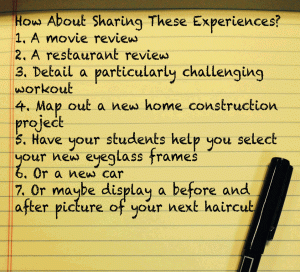Sharing the Connections That Students Value
In a youth culture that’s all about sharing minutiae, teachers can develop a deeper relationship with students by sharing appropriate details from their own lives.
Your content has been saved!
Go to My Saved Content.Sometimes in our social studies department meetings, we'll ask one another, "How's your supplemental?" Teachers who coach a sport or advise a group receive supplemental pay. So when we ask about supplementals, we're referring to the one class that you courageously navigate each day for which you should be rewarded with an additional line item in your paycheck!
I know you have a supplemental. Before this daily trial by fire, you take a deep breath and mutter to yourself, "Showtime!" Then you enter the fray. Each semester, I slowly (and at times painfully) grow to love my supplemental. My Fall 2015 Edition was my lunch-fueled 7th Period Posse. They're a challenge -- but they're worth it!
Which brings me to my lovely wife, Penny Sturtevant. Penny is a middle-school principal. Between us, we have 60 years of public education experience. As you can imagine, we frequently talk shop. During our lifetimes, we've witnessed a titanic evolution in classroom management practices.
Penny and I offer a more enlightened and enjoyable approach.
Penny's Story: How Can I Help My Staff Become Teachers of Influence?
Last year, "teacher of influence" was our building's guiding phrase. John Hattie, in his landmark book Visible Learning, created a list of 138 influences on student learning. He ranked student-teacher relationships in 11th place, far ahead of many things one might think more important. Not only does learning improve when students and teachers connect, but classroom management also improves. This is great for kids, and of course, it makes our jobs in the office less hectic.
Last August, I decided to open the year with something different after watching my husband conduct PD on how to connect with students. He told a personal story and then challenged the audience to share stories with one another. Instead of my typical focuses on pedagogy, I decided to try Jim's activity. The ensuing engagement was powerful!
Jim’s Story: How Can a High-School Teacher Connect With Students?
My strategy for managing my 7th Period Posse has been simple: bond with them! But kids can be darned resistant to their instructor's overtures!
Instead of coming on too strong, I propose focusing on approachability. In order to coax students out of their shells, melt arctic exteriors, or win over the disruptive, teachers need to become intriguing, familiar, and safe.
A great way for teachers to achieve this is to tell stories. . . about themselves! Educators should bring students into their world. Not literally, of course. I'm not proposing that you invite them to your house for dinner, but instead, allow them to live vicariously through some of your interesting experiences. Teachers need to allow students to get to know them. Isn’t that the way most relationships are forged?
To give them more power, enhance personal narratives with images. Become photojournalists. If something interesting happens this weekend, how about capturing images and sharing them in class on Monday morning?

Sometimes, when I spout my ideas about sharing personal stories, colleagues push back with comments like these:
- What a tremendous waste of instructional time!
- Teachers need to be respected. They're not entertainers!
- My students would look at me like I'm an idiot!
What these reservations fail to appreciate (and this is most important) is that contemporary youth are totally comfortable sharing and reading trivial details about daily existence. Think about what students post on social media.
Also, I've found that improved student-teacher rapport magically leads to better student performance. How interesting! You don't have to be a court jester or a stand-up comedian -- or an extrovert, for that matter. Your stories don't have to be funny. Granted, when you first go down this sharing path, some kids might be dismissive or hostile. But I've often found that the kids who are initially the most persnickety later tend to be the first to start sharing back. So if you experience some initial resistance, just be cool and keep trying. Your students will come around.
Penny's PD
After welcoming my staff, I described my summer adventure of climbing Old Rag Mountain in Virginia. On the screen behind me, I displayed a beautiful panorama of Old Rag. I chronicled my ascent and my feelings when I reached the summit. Some of my teachers appeared impressed. Others seemed puzzled, wondering what my story had to do with preparing for the school year. I imagined them thinking, "When does the traditional PD begin?"
I prompted my teachers to find an interesting picture on their phones. I then gave them ten minutes to circulate around the room sharing and describing their image. I watched with great interest as the energy level in the room soared! They were no longer passive listeners, but active learners.
I asked for volunteers to share something interesting that they learned about a colleague. I was thrilled that many stepped forward. We learned about summer vacations, births, new homes, new relationships, and life milestones. Curiosities were fueled and so were openings for deeper relationships. Finally, I had them dialogue about ways to utilize personal stories to build relationships with students.
This was not a simple icebreaker! It created a powerful base for our school's focus on becoming teachers of influence.
The Magic of Sharing
You might think it odd to announce to your class what you prepared for dinner and display images for impact, but your students won't. They'll embrace it -- enthusiastically! Bond with students by sharing your life, and in the process, watch classroom management improve and learning blossom.
How do you create connections with your students?
